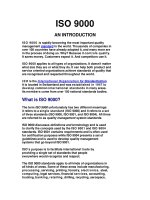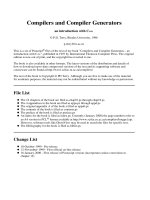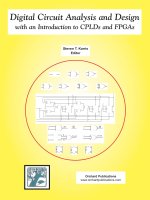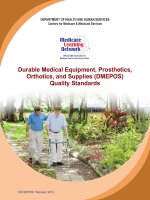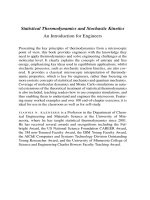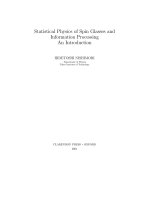Machinery and equipment safety – an introduction ppt
Bạn đang xem bản rút gọn của tài liệu. Xem và tải ngay bản đầy đủ của tài liệu tại đây (960.1 KB, 22 trang )
WorkSafe
MACHINERY AND EQUIPMENT SAFETY
– AN INTRODUCTION
1ST EDITION
WorkSafe
Infoline 1300 307 877
(for the cost of a local call statewide)
Westcentre 1260 Hay Street West Perth Western Australia 6005
PO Box 294 West Perth Western Australia 6872
Administration: (08) 9327 8777
Facsimile: (08) 9321 8973
National Relay Service: 13 36 77
Website: www.worksafe.wa.gov.au
Email:
Regional ofces
Goldelds/Esperance (08)90215966
Great Southern (08) 9842 8366
Kimberley (08) 9169 2811
Mid-West (08) 9964 5644
North-West (08) 9185 0900
South-West (08) 9722 2888
This publication is available in other formats to assist people with special needs.
DP1979/2007/1- January 2008 - 2000
Introduction 1
1. Key principles of machinery and
equipment safety
2
1.1 Mechanical hazards 3
1.2 Non-mechanical hazards 4
1.3 Access hazards 5
2. Risk control of machinery and
equipment hazards
7
2.1 Risk control of machinery and equipment
hazards (general) 8
2.2 Risk control of mechanical hazards 9
2.3 Risk control of non-mechanical hazards 13
2.4 Risk control of access hazards 14
3. Purchasing machinery and equipment list. . . . . . . . 18
4. Information and guidance: Where to get
more information and assistance
20
CONTENTS
Acknowledgement
WorkSafe Western Australia acknowledges WorkSafe Victoria for the original development of this publication.
Disclaimer
Information in this publication is provided to assist people in meeting their occupational safety and health obligations. While information is
correct at the time of printing, readers should check and verify any legislation referenced in this publication to ensure it is correct at the time
of use.
Changes in law after this document is published may impact upon the accuracy of information. This information is provided as a service to
the community. It is made available in good faith and is derived from sources believed to be reliable and accurate at the time of publication.
MACHINERY AND EQUIPMENT SAFETY – AN INTRODUCTION 1
INTRODUCTION
Machinery and Equipment Safety: An Introduction is provided in accordance with
the Occupational Safety and Health Act 1984 (OHS Act) to assist employers and
employees comply with their duties and obligations.
This guide is an introduction to managing the risks associated with use of
machinery and equipment in the workplace.
Employers can use this guide to:
• identifymachineryandequipmenthazardsintheworkplace
• eliminateorreducetheriskofthosehazardscausingharm.
The guide will also be useful to anyone else who is interested in machinery and
equipment safety, such as employees and Safety and Health Representatives.
WorkSafe also has additional guidance supporting all topics introduced in this
document. To find out more or to seek further technical information with regard
to your machinery and equipment, refer to Section 4 of this document.
CONSULTING EMPLOYEES AND SAFETY AND HEALTH
REPRESENTATIVES
Consultative processes allow people to provide input and raise potential safety
concernsabouttheworktheyundertake.Althoughhazardsassociatedwith
machinery and equipment are often easily identified, the ways in which
peoplecangainaccessto,ormaybeexposedto,hazardsrequireadetailed
understanding of how they do their job.
2 MACHINERY AND EQUIPMENT SAFETY – AN INTRODUCTION
KEY PRINCIPLES OF
MACHINERY AND
EQUIPMENT SAFETY
1
RISKS ASSOCIATED WITH:
1.1 Mechanical hazards
that cannot be eliminated must be
controlled to prevent harm.
1.2 Non-mechanical hazards
that cannot be eliminated must be
controlled to prevent harmful exposure.
1.3 Access hazards
that cannot be eliminated must be
controlled to provide safe access
(for operation, maintenance, repair,
installation, service, cleaning or
decommissioning).
MACHINERY AND EQUIPMENT SAFETY – AN INTRODUCTION 3
1.1 MECHANICAL HAZARDS
Machines have moving parts. The action of moving parts may have sufficient force
in motion to cause injury to people.
Whenreviewingmachineryandequipmentforpossiblemechanicalhazards,
consider:
• machineryandequipmentwithmovingpartsthatcanbereachedbypeople
• machineryandequipmentthatcanejectobjects(parts,components,products
or waste items) that may strike a person with sufficient force to cause harm
• machineryandequipmentwithmovingpartsthatcanreachpeoplesuchas
booms or mechanical appendages (arms)
• mobilemachineryandequipment,suchasforklifts,palletjacks,earthmoving
equipment, operated in areas where people may gain access.
Commonmechanicalhazardsandassociatedrisksformachineryandequipment
are shown below.
FURTHER INFORMATION
Commission for Occupational Safety and Health guidance notes:
Plant in the workplace•
Powered mobile plant•
Safe movement of vehicles at workplaces•
Working safely with forklifts•
Robotic arms can reach over their base, move
with remarkable speed and high force, and
can cause injury if controls to separate people
from moving plant are not implemented.
Mobile plant operated in areas where people
work may cause injury through collision. Traffic
control and segregation are forms of control.
KEY PRINCIPLES OF MACHINERY
AND EQUIPMENT SAFETY
HAZARD RISK
Rotating shafts, pullies, sprockets and gears Entanglement
Hard surfaces moving together Crushing
Scissor or shear action Severing
Sharp edge – moving or stationary Cutting or puncturing
Cable or hose connections Slips, trips and falls (e.g. oil leaks)
4 MACHINERY AND EQUIPMENT SAFETY – AN INTRODUCTION
KEY PRINCIPLES OF MACHINERY
AND EQUIPMENT SAFETY
1.2 NON-MECHANICAL HAZARDS
Non-mechanicalhazardsassociatedwithmachineryandequipmentcaninclude
harmful emissions, contained fluids or gas under pressure, chemicals and chemical
by-products, electricity and noise, all of which can cause serious injury if not
adequatelycontrolled.Insomecases,peopleexposedtothesehazardsmay
not show signs of injury or illness for years. Where people are at risk of injury
due to harmful emissions from machinery and equipment, the emissions should be
controlled at their source.
When reviewing machinery and equipment for possible non-mechanical
hazards,considerhowmachinesandequipmentcanaffectthearea
(environment) around them.
Commonnon-mechanicalhazardsareshownbelow.
FURTHER INFORMATION
Commission for Occupational Safety and Health codes of practice:
Managing noise at workplaces•
Spray painting•
Commission for Occupational Safety and Health guidance notes:
Controllingwooddusthazards•
ControllingIsocyanatehazardsatwork•
Prevention of carbon monoxide poisoning from petrol and gas powered •
equipment
Material safety data sheets •
NON-MECHANICAL HAZARDS
Dust Mist (vapours or fumes)
Explosive or flammable atmospheres Noise
Heat (radiated or conducted) Ignition sources (flame or spark)
High intensity light (laser, ultra-violet) Molten materials
Heavy metals (lead, cadmium, mercury) Chemicals
Steam Pressurised fluids and gases
Ionising radiation (x-rays, microwaves) Electrical
Woodworking dust generated by a buzzer is
removed via forced extraction and ventilation.
Welding fumes are extracted via flexible,
locatable forced extraction and ventilation system.
MACHINERY AND EQUIPMENT SAFETY – AN INTRODUCTION 5
KEY PRINCIPLES OF MACHINERY
AND EQUIPMENT SAFETY
1.3 ACCESS HAZARDS
People must be provided with safe access that is suitable for the work they perform
in, on and around machinery and equipment. A stable work platform suited to the
nature of the work that allows for good posture relative to the work performed, sure
footing, safe environment and fall prevention (if a fall may occur) is a basic
requirement.
As an example, cooling towers on building roofs may have poor access, yet must
be attended by a service person at predictable times for water treatment, chemical
dosing or monitoring of automated dosing equipment. People performing these
tasks must be provided with the means to get themselves and any equipment they
require onto the roof with no risk or minimal risk of fall or injury.
When thinking about safe access to machinery and equipment, think about how,
who, when and what:
• whowillbeworkingonoraroundthemachineryandequipment?
• peoplerequiredtoworkinenclosedareaswheretheatmospherecould
beharmful,suchaspits,tanksorstoragevessels?
• whatequipmentormaterialsneedtobecarriedtoundertakethetask?
• whereandwhenisaccessrequiredforoperation,maintenanceandcleaning?
• howwillpeoplegainsafeaccess(walkway,gantry,elevatedworkplatform
orladder)?
• whatworkwillbecarriedoutduringaccess?
• willpeoplebenearorexposedtoanunidentifiedmechanicalor
non-mechanicalhazardatthetimeofaccess?
• hasconsultationoccurredwithemployeesorcontractorsregardinghowthey
intend to gain access, and what equipment and work platform or structure is
bestsuitedfortheintendedtask?
Access
Access needs can be predicted and access planning must occur in advance.
People need access to machinery and equipment in the workplace (either continually
or occasionally) for tasks such as operation, maintenance, repair, installation,
service or cleaning. These tasks are examples of access that can be predicted.
Access may vary during each stage of machinery and equipment life cycle.
For example:
• installationorremoval
– complete access from every area may be required, and involve
disconnection or connection of services such water, air, pipes,
installation of electrical cable to switch board, etc.
• operation
– access for set-up, operation and adjustment.
• maintenance,repair,cleaning,alterationoradaptation
– access to remote areas may be required.
FURTHER INFORMATION
Commission for Occupational Safety and Health code of practice:
Prevention of falls at workplaces •
Commission for Occupational Safety and Health guidance note:
Working alone•
Permanently fixed gantries, ladders and
walkways are incorporated into this machinery
and equipment to reduce the risk of a fall from
height occurring during operation
and maintenance.
6 MACHINERY AND EQUIPMENT SAFETY – AN INTRODUCTION
KEY PRINCIPLES OF MACHINERY
AND EQUIPMENT SAFETY
EXAMPLES OF COMMON HAZARDS BY TYPE OF WORKPLACE ACTIVITY
PEOPLE WHO INSTALL OR DISMANTLE MACHINES AND EQUIPMENT COULD:
• workinisolation
• workonmachinesandequipmentatheightorovermachineryorequipmenttoconnectservices(suchaselectricity,airorwater)
• workinlowlightorwithbrightdirectionallight
• accessmachineryandequipmentfromthetop,sidesorunderneath
• workwith/nearcranes,forkliftorriggingtoliftmachineryandequipment
• workinconfinedspaces
• usepowertools,welders,extensionleads,whichpresentelectricalhazardsifdamagedorwet.
PEOPLE OPERATING MACHINES AND EQUIPMENT COULD:
• berequiredtoplacetheirhandsclosetothemechanismofthemachineryorequipmentthatdoesthework,andmaybeinjured
if caught or trapped by moving parts
• beexposedtoconstantharmfulnoise,radiatedenergyorfumesbeingemittedfromthemachineryandequipmenttheyareoperating
or are close to
• inadvertentlybumporknockpoorlyplacedcontrolleversorbuttons
• berequiredtomakeadjustmentstothemechanismofmachineryandequipmentwhilethemachineisinmotion
• berequiredtoclearawayscrap
• makeminoradjustmentsorreachintothemovingmechanismofthemachinetheyareoperating.
PEOPLE PROVIDING MAINTENANCE OR REPAIR SERVICES COULD:
• workalone
• workonmachinesandequipmentatheight,orovermachinesandequipmenttoconnectservices(suchaselectricity,airorwater)
• accessmachinesandequipmentfromtherearorsides
• needtoenterconfinedspacesoflargermachineryandequipment
• betrappedbymechanismofthemachineryandequipmentthroughpoorisolationofenergysourcesorstoredenergy,suchas
spring-loaded or counter-balance mechanisms, compressed air or fluids, or parts held in position by hydraulics or pneumatic (air) rams
• moveheavypartswhenchangingtheset-upofmachineryandequipment,orrepairingfailedpartssuchaselectricmotors
or gear box assemblies
• disableorremovenormalsafetysystemstoaccessmachinesandequipmentmechanism.
PEOPLE PROVIDING CLEANING SERVICES COULD:
• workalone
• accessmachinesandequipmentfromtherearorsidesorinunexpectedways
• climbonmachinesandequipment
• enterconfinedspacesoflargermachinesandequipment
• becometrappedbymechanismofthemachineryandequipmentthroughpoorisolationofenergysourcesorstoredenergy,suchas
spring-loaded or counter-balance mechanisms, compressed air or fluids, or parts held in position by hydraulics or pneumatic (air) rams
• workwithchemicals
• operateelectricalequipmentinwetareas.
MACHINERY AND EQUIPMENT SAFETY – AN INTRODUCTION 7
2
RISK CONTROL OF
MACHINERY AND
EQUIPMENT HAZARDS
2.1 Risk control of machinery and
equipment hazards (general)
2.2 Risk control of mechanical hazards
2.3 Risk control of non-mechanical hazards
2.4 Risk control of access hazards
8 MACHINERY AND EQUIPMENT SAFETY – AN INTRODUCTION
2.1 RISK CONTROL OF MACHINERY AND EQUIPMENT
HAZARDS (GENERAL)
Whereexposuretomachineryandequipmenthazardscannotbeeliminated or
substituted for machinery and equipment of improved design, risk control(s) must
beappliedtothehazardsthatpreventsorreducestherisk(chance)ofinjuryor
harm. Health and safety laws require the highest order control be applied so far
as is reasonably practicable.
Higher order machinery and equipment risk controls are preventative by nature,
are effective and durable for the environment it is used in, and deal directly with
the hazard at its source.
Lower order machinery and equipment risk controls, such as personal protective
equipment (PPE), can prevent injuries, but are generally not as effective as higher
order controls, as they rely more on employee behaviour, maintenance programs
and supervision.
Administrative controls use systems of work to reduce risk by providing a
framework of expected behaviours. Examples are rotation of staff to reduce
exposuretoahazard,oradocumentedsafesystemofwork,suchas‘lock
out-tag out’. These types of controls rely on extensive instruction, information,
training and supervision. In terms of time and ongoing administration by managers
and employers to ensure the desired behaviour occurs, administrative controls can
bethemostexpensiveandleasteffectiveformofhazardcontrol.
Note: The use of PPE and administrative controls are low or last order controls
usedtodealwithanyresidualriskassociatedwiththehazard.
As such, these last resort controls can be used in support of higher order controls
thatdealwithahazardatitssourceandshouldnotbeconsidered
as the sole means of control. These types of risk controls require constant
monitoring and reinforcement.
Effective machinery and equipment risk controls reflect some or all of the
following characteristics:
• thehazardiscontrolledatitssource
• contactoraccesstothehazardisprevented
• sturdyconstruction(correctmaterialswithfewpointsofpotentialfailure)
• fail-safe(failureofthecontrolsystemtobeeffectivewillresultinmachinery
shut-down)
• tamper-proofdesign(asdifficultaspossibletobypass)
• presentsminimumimpedimenttomachineryandequipmentoperator
• easytoinspectandmaintain
• doesnotintroducefurtherhazardsthroughactionoftheriskcontrol.
RISK CONTROL OF MACHINERY
AND EQUIPMENT HAZARDS
Centre lathe: The exposed rotating chuck
of a centre lathe can eject parts or tools with
great force, cutting fluid fumes are difficult
to contain and the machinery requires
manual set-up.
CNC Lathe: Substituting a centre lathe with
a CNC lathe (Computer Numeric Control) is an
example of improved risk control of machinery
and equipment through improvement in design.
MACHINERY AND EQUIPMENT SAFETY – AN INTRODUCTION 9
RISK CONTROL OF MACHINERY
AND EQUIPMENT HAZARDS
Fences, barriers, guards and interlocked gates
separate people from the hazardous action
of machinery and equipment.
An old style power press incorporating a
manual interlock and adjustable guarding.
If the guard slides up, a connected metal
bar separates the clutch mechanism and
the press will not activate.
The guard can be adjusted to provide an
opening by releasing retaining bolts on the
guard face to allow individual panels to move.
Adjustment must be performed by an
experienced person to ensure the resulting
opening only provides room necessary to
incorporate the material being fed in and
prevents hands or fingers intruding into the
danger area.
2.2 RISK CONTROL OF MECHANICAL HAZARDS
Separation is a simple and effective machinery and equipment risk control.
Separation may be achieved by distance, barrier or time.
• Distanceseparationmeansapersoncannotreachthehazardduetodistance.
• Barrierseparationmeansaneffectivebarrierorguarddeniesaccessand
controls ejection of parts, products or waste.
• Timeseparationmeansatthetimeofaccess,themachineryorequipment
is disabled.
Examples include:
• physicalbarriersandguardssuchasfences,screensorfixedpanelsof
various materials
• variousformsofguardingandinterlocking(asdescribedinAustralianStandard
AS 4024, part 1601 and part 1602, Safety of Machinery)
• makingthehazardinaccessiblebyreach(wherethedistancebetweenaperson
andthehazardformsaneffectivebarrier).
Note: When considering the suitability of distance guarding, also consider the safe
access requirements of maintenance people who gain access by ladder, scaffold or
elevated work platform.
Guarding
A guard can perform several functions: it can deny bodily access, contain ejected
parts, tools, off-cuts or swath, prevent emissions escaping or form part of a safe
working platform.
Guarding is commonly used with machinery and equipment to prevent access to:
• rotatingenddrumsofbeltconveyors
• movingaugersofaugerconveyors
• rotatingshafts
• movingpartsthatdonotrequireregularadjustment
• machinetransmissions,suchaspulleyandbeltdrives,
chain drives, exposed drive gears
• anydangerousmovingparts,machinesorequipment.
Where access is not anticipated, a fixed guard can be permanently applied by
bonding agent, welding or secured with one-way screws. If access is generally
not required, a permanently fixed barrier is the preferred option.
Whereaccesstothehazardisinfrequent,theinstallationofa fitted guard that
can be removed by use of a tool may be an acceptable control, where the tool
to remove the barrier or guard is not normally available to the operator.
Adjustable guarding incorporates movable sections or panels of the guard and
allows for material or parts to be fed into the guarded area while still preventing
bodily contact.
10 MACHINERY AND EQUIPMENT SAFETY – AN INTRODUCTION
RISK CONTROL OF MACHINERY
AND EQUIPMENT HAZARDS
The narrow throat of the mincer prevents a
person’s hand from accessing the hazard.
An old style press refurbished with an interlocked
safety cage and gate.
The control mechanism uses a combination of
pneumatics and electrical interlocking to ensure
the danger area of the press cannot be accessed
unless the press downstroke action is disabled.
Improved design and technology can be fitted to
older machinery and equipment to meet current
standards and reflect the latest knowledge
regarding ways to control hazards and risks
in the workplace.
Captive key systems: The key cannot be
removed unless it is in the off position. The
same key is used to unlock the access gate.
Only one key per system is retained by the
locking mechanism.
Tunnel guards provide a tunnel, aperture or chute in which material can be
inserted into the machinery and equipment, but due to the restrictive design
and depth of the opening, fingers, hands, arms or the entire person is prevented
from intruding into the danger area.
Where frequent cleaning is required, the guard may be constructed of mesh that
prevents intrusion of body parts but allows for hosing. Food production workplaces
that use conveyors in areas where hygiene or food safety is an integral part of the
operation use fixed mesh guarding of conveyor end rollers.
Interlock guarding occurs when the act of moving the guard (opening, sliding
orremoving)toallowaccessstopstheactionofthehazardousmechanism.
Interlock guarding works by:
• mechanicallydisconnectingthedrivemechanism(appliesabrakeordisengages
a clutch or geared mechanism)
• isolatingthepowersourceofthedrivemechanism(stopsthemotor)
• acombinationofmechanicalandpowerdisconnection.
Interlock guarding is generally achieved via mechanical or electrical means, but
may also include hydraulic or pneumatic control systems.
The energy stored in moving parts (momentum) can cause the mechanism of the
machine or equipment to run on for some time after the source of driving energy
has been removed.
For access panels or doors supporting an interlocking device that allows access
to mechanical parts that move for periods after the energy source is removed,
a separate mechanism to delay release of the retaining or locking mechanism
may be incorporated.
Captive key systems rely upon a single key that is shared between the
controlpanel(‘on’switch)andtheaccessgatelockofthephysicalbarrier
to the danger area. Removal of the key from the control panel can only occur when
the switch is in the off position, and the gate will only release the key
when in the locked position.
Captive key systems do not provide full isolation of the power source, but may
provide limited temporary access under controlled conditions.
Effective supervision, instruction and training are required as administrative
controls to ensure that only one key is available for the system, and the key
is not removed from the access gate or guard by a second operator while
a person is exposed to the danger area of the plant. Operations such as
maintenance, repair, installation service or cleaning may require all energy
sources to be isolated and locked out to avoid accidental start-up.
MACHINERY AND EQUIPMENT SAFETY – AN INTRODUCTION 11
RISK CONTROL OF MACHINERY
AND EQUIPMENT HAZARDS
A two-handed control option may be suitable
to ensure that a machine cannot operate until
both hands of the operator are clear of the
hazard area.
Other mechanical hazard risk control options
Simultaneous two-handed operation
Where a machine has only one operator, the use of simultaneous two-handed
operation buttons can serve as a risk control. This ensures that operation of the
hazardousmechanismcannotoccuruntilbothhandsareclearofthedangerarea.
The two buttons must be pushed at the same time and are located at a distance
from each other that prevents simultaneous operation by one hand.
The operation should be designed so that if either or both of the buttons are
released,thehazardousactionofthemachineorequipmentcannotbereached,
or if it can be reached, the mechanism returns to a safe state.
Presence sensing systems
If physical guards are not reasonably practicable, then a presence sensing system
can be used as a control to reduce risk. Presence sensing systems can be used
where people enter areas shared by moving production equipment.
Presence sensing systems are capable of providing a high degree of flexibility
with regard to access.
Presence sensing systems detect when a person is in the identified danger area,
and stops or reduces the power or speed of the mechanism at the time of entry
to provide for safe access.
Presence sensing systems can rely on foot pressure pads, infra-red sensing, light
beams or laser scanning. The most appropriate type of sensing device will depend
on the operating environment and access requirements.
Australian Standard AS 4024.2 provides guidance on design specification, ratings
on integrity and reaction times. Manufacturers’ specifications for installation and
maintenance must also be observed.
Specialist assistance may be required by experienced professionals to ensure
correct selection and installation of presence sensing systems. Companies
who manufacture or supply these systems also provide technical support
and installation assistance.
A light curtain used to disable the hazardous
mechanism of a machine must resist failure
and fault.
12 MACHINERY AND EQUIPMENT SAFETY – AN INTRODUCTION
RISK CONTROL OF MACHINERY
AND EQUIPMENT HAZARDS
Components relied on to protect people
from harm are designed and built to a high
standard, and display compliance ratings
relative to their reliability. They must also be
correctly installed to ensure their effective
operation.
Critical safety systems
A safety control system responsible for ensuring the safety of a person when
approachingoraccessingahazardiscalledacriticalsafetysystem.
Failureofthecriticalsafetysystemwillleaveapersonexposedtothehazard,
and in danger.
Critical safety systems may include barriers or guards fitted to prevent access, or
integrated complex interlocking and presence sensing systems. Failure to replace
guards, damaged perimeter fences that allow access and bypassed or disabled
interlocking systems are examples of critical safety systems failures that require
immediate attention to ensure the safety of people.
High integrity/fail-safe control
All safety control systems should be designed and built to prevent failure or, in
the event of failure, de-activate the operation of the machinery and equipment.
The extent to which a safety control system should tolerate faults is a function
of risk (likelihood and consequence), and is described fully in Australian Standard
AS 4024.1501 Safety Related Parts of Control Systems, which explains the
categories of control required as a function of increasing risk.
Many different types of machinery and equipment use high integrity safety systems
that disable a mechanism at the time of access. Some examples include:
• brakepress
• powerpress
• roboticmachine(automatedmachines)
• injectionmoulders
• poweredguillotines
• programmablelatheandmillingequipment
• industrialmixers
• mincingequipment
• plasmacuttingtables
• lasercuttingtables.
Redundant and self-monitoring fault detection systems
Redundant or dual systems (doubling up) and self-monitoring fault detection
systems are also effective methods to prevent failure of critical safety systems.
Selection and installation of these types of complex interactive control measures
may require expert or specialist assistance.
The Australian Standards provide information on plant safety systems and reflect
current state of knowledge and best practice. The AS 4024 Safety of Machinery
series of publications provides specific information for commonly used machine
types in industry such as woodworking or metal working machinery.
MACHINERY AND EQUIPMENT SAFETY – AN INTRODUCTION 13
RISK CONTROL OF MACHINERY
AND EQUIPMENT HAZARDS
2.3 RISK CONTROL OF NON-MECHANICAL HAZARDS
The first step in selecting suitable and effective controls for non-mechanical
hazardsistounderstandthenatureofemissionsthatcanbereleasedby
machinery and equipment in the workplace, where those emissions collect
and the way they may cause harm.
• Separatingpeoplefromnon-mechanicalhazardsisnecessarywherethe
emission cannot be controlled at the source through elimination or substitution.
Hazardousmachineryandequipmentemissioncontrolsrelylargelyonisolation
ofpeoplefromthehazardousemission.
Hoods, lids, covers or impervious guards (solid barriers that prevent escape
of the emission) can serve to contain a number of different types of emissions
within machinery or equipment.
For potentially harmful substance exposures from machinery and equipment,
such as mist, fumes, vapour or dust, and where it is not reasonably practicable
to control the emission at its source, ventilation and extraction systems are used
toremovethehazardousatmospherefromtheworkenvironment.
• Fornoise,guardingmayalsoservetomutenoiseemissionsthroughapplication
of sound absorbing materials. Other emissions such as lasers, ultra-violet light,
bright light or welding flash can also be safely screened to prevent potential
harmful exposure.
• Oilleaksfrommachineryorequipmentmaypresentaserioussliphazard.
Bypreventingoilleaksthroughroutinemaintenance,orcontainingleaking
oilwithadriptrayorthroughspillcontainmentstrategies,theriskthehazard
presents is controlled.
Personal protective equipment
Where it is not reasonably practicable for emissions to be controlled at their source
or removed or reduced through effective ventilation, extraction or diversion, the use
of personal protective equipment (PPE) as a final measure must be considered to
ensure safety.
PPE is a lower order control and can only be used where higher order controls
are not reasonably practicable or are not totally effective.
Selection and use of PPE requires careful consideration, as there are many
differenttypesthatreducetheriskofinjuryofcontactorexposuretoahazard.
Incorrect use of PPE or purchasing inappropriate PPE can contribute to serious
workplace incidents.
PPEthatisuncomfortable,restrictiveorheavymaycreatesecondaryhazards,
and, as a result, constant supervision may be necessary to ensure it is used
effectively.
Ear muffs. Particle half face respirator.Gloves.
Welding mask.
Safety glasses.
14 MACHINERY AND EQUIPMENT SAFETY – AN INTRODUCTION
RISK CONTROL OF MACHINERY
AND EQUIPMENT HAZARDS
2.4 RISK CONTROL OF ACCESS HAZARDS
Confined space
Largermachineryandequipmentmaycontaininternalareaswhereahazardous
atmosphere may occur by design or as a result of the work being done.
A confined space may exist where people require access to a mostly closed area
that presents difficult or restricted path of access, where oxygen levels may be
depleted or displaced, or where harmful levels of contaminate, such as gas, vapour
or dust, exist.
Training in confined space entry and having another person present in the
immediate vicinity during the work is a legal requirement that must be observed
prior to allowing people to enter a confined space.
Working at height
Providing people with a suitable work platform for the task being undertaken
reduces the risk of injury from falling from machinery and equipment.
Often‘safeaccess’equipmentmadeavailableduringinstallationofmachineryor
equipment is removed after commissioning. Workplace managers may not have
considered or recognised the need to provide similar means to gain safe access
to parts of machinery and equipment at height or in awkward locations for
maintenance, repair, service or cleaning activities.
Safe access at height can be broken into three categories. Each category has in
common the need to provide a stable, safe platform suitable for the work to be
undertaken, and to be equipped to support and retain a person within the confines
of the platform.
1. Fixed or permanently installed access platforms:
• gantries
• mezzaninefloors
• fixedplatforms
• stairways.
2. Mobile elevated work platforms (EWPs):
• scissorlifts
• knucklebooms.
Note: Safe work practices must take into account the risk of trapping an
operator between the EWP and a fixed structure, e.g. overhead beams,
electrical cables, pipes.
3. Temporary platforms:
• scaffolding
• ladders.
Where safe working platforms are used and the risk of a fall remains, travel
restraint and fall arrest harnesses can be used where a suitable point of
attachment exists. Harness systems, anchor points and shock absorbing
lanyards must be compatible at each point of attachment from the anchor
point to the harness, with approved and rated latching devices to ensure the
integrity of the system.
When using fall arrest systems, specialist assistance may be necessary to
select appropriate equipment, provide effective training in use and inspection,
and develop an emergency retrieval plan to recover a person suspended in a fall
arrest harness. People suspended by a harness for short periods of time may
suffer serious health effects or may have incurred injury during the fall prior to the
fall arrest device deploying. Emergency retrieval plans should allow for immediate
local response in safely retrieving people to avoid fatalities.
Note: Occupational Safety and Health Regulations 1996 prescribe specific
requirements that must be taken into account when determining risk controls for
both confined spaces and working at heights.
Fixed access platform.
Mobile work platform with fall arrest harness.
Temporary mobile platform.
FURTHER INFORMATION
Commission for Occupational Safety
and Health code of practice:
Prevention of falls in the •
workplace
MACHINERY AND EQUIPMENT SAFETY – AN INTRODUCTION 15
RISK CONTROL OF MACHINERY
AND EQUIPMENT HAZARDS
Lock out–tag out: Removing and controlling energy sources during access
People performing tasks such as maintenance, repair, installation, service and
cleaning are highly vulnerable, and have a higher risk of being killed or maimed
through inadvertent operation of machinery and equipment they are working in,
on or around.
Accidental start-up or movement of a machine mechanism can occur if control
levers or buttons are bumped or knocked, if a short circuit of the control system
occurs, when hydraulic or air pressure is released, or when undoing retaining bolts.
It is essential that people who work in, on or around machinery and equipment are
notexposedtohazardsduetoaccidentalstart-upormovementofthemechanism.
(Reference: Australian Standard AS 4024.1603 Safety of Machinery.)
The following is an overview of the lock out–tag out process:
•shut-down the machinery and equipment
•identifyallenergysourcesandotherhazards
•identify all isolation points
•isolate all energy sources
•de-energise all stored energies
•lock out all isolation points
•tagmachinerycontrols,energysourcesandotherhazards
•testby‘trying’toreactivatetheplantwithoutexposingthetesterorothers
to risk (failure to reactivate ensures that isolation procedures are effective
and all stored energies have been dissipated).
Identifying energy sources
All energy sources likely to activate the machinery and equipment and expose
peopletohazardsshouldbeidentifiedpriortoworkbeginning.
Such energy sources include:
• electricity(mains)
• batteryorcapacitorbanks
• fuels
• heat
• steam
• fluidsorgasesunderpressure(water,airsteamorhydraulicoil)
• storedenergy
• gravity
• radiation.
Iforiginaldesignerandinstaller‘asbuilt’diagramsofmachineryandequipment
installations are not available, new diagrams and photographs showing location
and details of various isolation points of machinery and equipment should be
developed as part of the isolation procedures. Isolation points may include
switches, valves, energy lines, pipes, power sources.
These diagrams and photographs can then be used, along with written procedures,
for information and training.
16 MACHINERY AND EQUIPMENT SAFETY – AN INTRODUCTION
RISK CONTROL OF MACHINERY
AND EQUIPMENT HAZARDS
De-energise stored energies
Any or all of the following steps are necessary to guard against energy left in
the machinery and equipment after it has been isolated from its energy sources:
• inspectthemachineryandequipmenttomakesureallpartshave
stopped moving
• installgroundwires
• releasethetensiononspringsorblockthemovementofspring-loadedparts
• blockorbracepartsthatcouldfall
• blockpartsinhydraulicandpneumaticsystemsthatcouldmovefrom
pressure loss
• bleedthelinesandleaveventvalvesopen
• drainprocesspipingsystemsandclosevalvestopreventtheflowof
hazardousmaterial
• ifalinemustbeblockedwherethereisnovalve,useablankflange
• purgereactortanksandprocesslines
• dissipateextremecoldorheat,orprovideprotectiveclothing
• ifstoredenergycanaccumulate,itmustbemonitoredtoensureitstays
belowhazardouslevels.
Isolation procedures
Isolation procedures in each workplace vary in detail because of differences in
machineryandequipment,powersources,hazardsandprocesses.However,
if adequate interlocking is not possible, or the maintenance, repair, installation,
service or cleaning requires the method of guarding or interlocking to be bypassed
or removed, an isolation procedure should be implemented.
Note: Activating operational stop buttons, emergency stop devices or interlock
devices is not equivalent to the isolation of power sources or the release of
stored energy.
Lock out
Isolation devices
A wide range of devices is available for locking out energy sources and other
hazardsthatcouldposearisktopeopleworkingonmachineryandequipment.
These devices include switches with a built-in lock, and lock outs for circuit
breakers, fuses and all types of valves.
Also readily available are chains, safety lock out jaws (sometimes called hasps),
which accommodate a number of padlocks, and sets of robust safety padlocks.
Only devices that incorporate a lock or accommodate one or more padlocks are
suitable lock out devices.
MACHINERY AND EQUIPMENT SAFETY – AN INTRODUCTION 17
RISK CONTROL OF MACHINERY
AND EQUIPMENT HAZARDS
One person – one lock
If more than one person is working on the same item of machinery and equipment,
each person should attach their own lock to prevent the isolator
being opened while their specific task is in progress.
The isolation procedure should identify common lock out points to ensure
energy cannot be restored while someone is still working on the machinery
and equipment.
If two or more people are working on machinery and equipment that is isolated
through several lock out points, each person should attach a lock and tag to each
lock out point.
To avoid the need for multiple locks on each lock out point, a lock box may be
used. Under this system, each lock out point is locked by only one lock, and the
keys to the locks of the machinery’s lock out points are placed inside a box that
is locked by all the individual locks of people working on the same plant.
One lock – one key
Each person working on the machinery and equipment should have their
own lock, key and tag. There should be no duplicate key available for any lock,
except a master or duplicate key for use in an emergency that is secured and
not readily available.
During inspection, repair, maintenance, cleaning or adjustment of the machinery
and equipment, the one key to each person’s lock should be held only by that
person, who is responsible for both locking and unlocking the lock out device.
Multiple energy sources
Ifmorethanoneenergysourceorhazardhastobelockedouttoenablesafe
shut-down of the machinery and equipment, the single key to each lock out device
should be held by the same person.
Tag out
A tag on its own is not an effective isolation device. A tag acts only as a means
of providing information to others at the workplace. A lock should be used as an
isolation device, and can be accompanied by a tag.
FURTHER INFORMATION
Commission for Occupational Safety and Health guidance note:
Isolation of plant•
Tag and lock.
Multiple locks.
Valve lock and tag.
18 MACHINERY AND EQUIPMENT SAFETY – AN INTRODUCTION
3
PURCHASING
MACHINERY AND
EQUIPMENT LIST
PEOPLE
•whowillcomeintocontactwiththemachineryandequipment?
•whatarepeoplerequiredtodo?
•howwillworkbecarriedoutandcompleted?
•basedontheknowledgeofexistingmachineryandequipment,whatimprovementsshouldthepurchaserspecifywhenbuying
newmachineryandequipment?
DOCUMENTATION AND TRAINING
•whatsupportingdocumentationwillaccompanythenewmachineryandequipment?
•towhatstandardshasthemachineryandequipmentbeenmanufactured(Australian,European,Japanese,American)?
•whatsupportisofferedbymachineryandequipmentsuppliers(service,training,maintenance)?
•whatoperatingandmaintenanceinformationissuppliedwiththenewmachineryandequipment?
•isthesuppliedinformationsufficienttoprovidethebasisofaworkplacetrainingpackage?
•ifthemachineryandequipmentisrefurbishedorsecond-hand,howdotheriskcontrolscomparewithlikenewmachineryandequipment?
•haveyouallowedextraresourcestoupgradeexistingriskcontrolstoreflectcurrentstateofknowledge?
The following list provides topics for consideration and consultation when purchasing
machinery and equipment. It is important to also note that under Section 23 of the OSH Act
1984, manufacturers and suppliers of plant have specific duties to ensure plant is safe.
MACHINERY AND EQUIPMENT SAFETY – AN INTRODUCTION 19
LOCATION
•whereisthemachineryandequipmenttobelocated,andhowmuchspacedoesitrequire?
•isthereenoughroomtoaccessyourmachineryandequipmentforservicing,maintenance,repairorcleaning?
•dopeoplewalkpastorworkincloseproximitytotheproposedmachineryandequipmentlocation?
•isthereenoughlight?
•istheresufficientventilation?
OPERATION AND MAINTENANCE
•willthemachineryandequipmentintroducemorenoisetotheworkplace?
•willyourmachineryandequipmentperformataskotherthanwhatitwasdesignedfor?
•whattypesofemissionsdoesthemachineryandequipmentproducewhenoperatedorcleaned,suchasnoise,fumes,lightandheat?
•whataretheexpectedhoursofmachineryandequipmentoperation?
•howwillmaterialarrive,andhowisproductgoingtoberemovedaftertheprocessiscomplete?
•arethereenvironmentalfactors,suchashazardousatmospheresofflammablevapoursordustorwater,thatmayaffectthemachinery
andequipment,theoperatorsormaintenanceworkers?
•doesthemachineryandequipmenthaveconfinedspaces?
•doesthemachineryandequipmenthavevalvesorisolationpointslocatedatheight?
VARIOUS
•willthemachineryandequipmentfitthroughthedoor?
•isthefloorofyourworkplacestrongenoughtosupportthemachineryandequipment?
•doyouunderstandthatifyoupurchasemachineryandequipmentoutsideVictoria,thenyoualsotakeonthedutiesoftheimporter?
•doyouunderstandthedutiesofanimporter?
•doyouunderstandthatifyoualteroradaptmachineryandequipmenttoperformanalternatefunction,thenyoualsotakeontheduties
ofthedesignerforthosealterations?
•doyouunderstandthedutiesofadesigner?
•ifthemachineryandequipmentismobile,wherewillitoperateandwhomaybeinthearea?
•inwhatterrainwillthemobilemachineryandequipmentoperate?
Refer to Section 4 for more information.
PURCHASING MACHINERY
AND EQUIPMENT LIST
20 MACHINERY AND EQUIPMENT SAFETY – AN INTRODUCTION
4
INFORMATION
AND GUIDANCE
NOT SURE WHERE TO GO FROM HERE?
WorkSafe
Telephone: 1300 307 877
Website: www.worksafe.wa.gov.au
Email:
General:
• employeescancontacttheirunion
• employerscancontacttheirindustryassociation
Legislation:
• OccupationalSafetyandHealthAct1984
• Occupational Safety and Health Regulations 1996
For copies of the above Acts and Regulations, go to www.slp.wa.gov.au
Technical Standards:
• StandardsAustraliawww.saiglobal.com
• AS4024SafetyofMachinery

